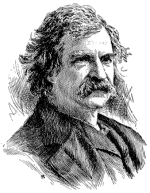The Boys’ Life of Mark Twain
by Paine

XXXVIII. Home Pictures
Mark Twain was now regarded by many as the foremost American author. Certainly he was the most widely known. As a national feature he rivaled Niagara Falls. No civilized spot on earth that his name had not reached. Letters merely addressed “Mark Twain” found their way to him. “Mark Twain, United States,” was a common superscription. “Mark Twain, The World,” also reached him without delay, while “Mark Twain, Somewhere," and “Mark Twain, Anywhere,” in due time came to Hartford. “Mark Twain, God Knows Where,” likewise arrived promptly, and in his reply he said, “He did.” Then a letter addressed “The Devil Knows Where” also reached him, and he answered, “He did, too.” Surely these were the farthermost limits of fame.
Countless anecdotes went the rounds of the press. Among them was one which happened to be true:
Their near neighbor, Mrs. Harriet Beecher Stowe, was leaving for Florida one morning, and Clemens ran over early to say good-by. On his return Mrs. Clemens looked at him severely.
“Why, Youth,” she said, “you haven’t on any collar and tie.”
He said nothing, but went to his room, wrapped up those items in a neat package, which he sent over by a servant to Mrs. Stowe, with the line:
“Herewith receive a call from the rest of me.”
Mrs. Stowe returned a witty note, in which she said he had discovered a new principle–that of making calls by instalments, and asked whether in extreme cases a man might not send his clothes and be himself excused.
Most of his work Mark Twain did at Quarry Farm. Each summer the family– there were two little girls now, Susy and Clara–went to that lovely place on the hilltop above Elmira, where there were plenty of green fields and cows and horses and apple-trees, a spot as wonderful to them as John Quarles’s farm had been to their father, so long ago. All the family loved Quarry Farm, and Mark Twain’s work went more easily there. His winters were not suited to literary creation–there were too many social events, though once–it was the winter of ’76–he wrote a play with Bret Harte, who came to Hartford and stayed at the Clemens home while the work was in progress. It was a Chinese play, “Ah Sin,” and the two had a hilarious time writing it, though the result did not prove much of a success with the public. Mark Twain often tried plays–one with Howells, among others–but the Colonel Sellers play was his only success.
Grand dinners, trips to Boston and New York, guests in his own home, occupied much of Mark Twain’s winter season. His leisure he gave to his children and to billiards. He had a passion for the game, and at any hour of the day or night was likely to be found in the room at the top of the house, knocking the balls about alone or with any visitor that he had enticed to that den. He mostly received his callers there, and impressed them into the game. If they could play, well and good. If not, so much the better; he could beat them extravagantly, and he took huge delight in such contests. Every Friday evening a party of billiard lovers–Hartford men–gathered and played, and told stories, and smoked, until the room was blue. Clemens never tired of the game. He could play all night. He would stay until the last man dropped from sheer weariness, and then go on knocking the balls about alone.
But many evenings at home–early evenings–he gave to Susy and Clara. They had learned his gift as a romancer and demanded the most startling inventions. They would bring him a picture requiring him to fit a story to it without a moment’s delay. Once he was suddenly ordered by Clara to make a story out of a plumber and a “bawgunstictor,” which, on the whole, was easier than some of their requirements. Along the book-shelves were ornaments and pictures. A picture of a girl whom they called “Emeline" was at one end, and at the other a cat. Every little while they compelled him to make a story beginning with the cat and ending with Emeline. Always a new story, and never the other way about. The literary path from the cat to Emeline was a perilous one, but in time he could have traveled it in his dreams.
 Continue...
Continue...![[Buy at Amazon]](http://images.amazon.com/images/P/B0006AHKG6.01.MZZZZZZZ.jpg)